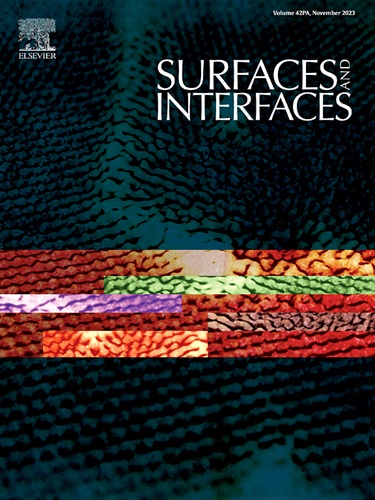CuOx within a self-supported reduced graphene oxide film for the selective oxidation of styrene
IF 5.7
2区 材料科学
Q2 CHEMISTRY, PHYSICAL
引用次数: 0
Abstract
Cu2+ ions on the surface of Cu-based nanoparticles (NPs) act as active sites for various reactions, including olefin oxidation. However, conventional Cu-based catalysts commonly used in laboratory studies are macroscale and powdery. In this study, we successfully synthesized CuO NPs containing Cu2+ and oxygen vacancies occupied by hydroxyl groups and metallic Cu (CuOx NPs) through tert‑butylhydroperoxide (TBHP) treatment. These CuOx NPs were encapsulated within a self-supported reduced graphene oxide (rGO) film with a lamellar structure (Cu-V@rGO-film-x) via polyol reduction combined with a cast-drying process. Remarkably, even at a low catalyst dosage (0.75 mol % Cu), [email protected] demonstrated superior catalytic activity compared to conventional sample, achieving significantly higher styrene conversion (82.4 % vs. 30.0 %) by mitigating the aggregation of CuOx@rGO sheets. This indicates that the lamellar structure of Cu-V@rGO-film-x facilitates efficient mass transfer. Moreover, [email protected] exhibited excellent stability, maintaining catalytic activity over four recycling cycles without significant decline. This study presents a facile and controllable strategy for encapsulating CuOx NPs in macroscale thin films with a lamellar structure, offering broad applications in catalysis and providing a rational design methodology for easily recyclable heterogeneous catalysts.

自支撑还原氧化石墨烯膜中的CuOx用于苯乙烯的选择性氧化
铜基纳米颗粒(NPs)表面的Cu2+离子作为各种反应的活性位点,包括烯烃氧化。然而,在实验室研究中常用的传统铜基催化剂是宏观和粉状的。在这项研究中,我们成功地通过叔丁基过氧化氢(TBHP)处理合成了含有Cu2+和氧空位被羟基和金属Cu占据的CuO NPs (CuOx NPs)。这些CuOx NPs通过多元醇还原结合铸造干燥工艺被封装在具有层状结构的自支撑还原氧化石墨烯(rGO)薄膜中(Cu-V@rGO-film-x)。值得注意的是,即使在低催化剂用量(0.75 mol % Cu)下,[email protected]也表现出比传统样品更好的催化活性,通过减轻CuOx@rGO片的聚集,实现了显著更高的苯乙烯转化率(82.4% vs. 30.0%)。这表明Cu-V@rGO-film-x的片层结构有利于有效的传质。此外,[email protected]表现出优异的稳定性,在四个循环中保持催化活性,没有明显下降。本研究提出了一种简单可控的将CuOx NPs封装在具有层状结构的宏观薄膜中的策略,在催化方面具有广泛的应用,并为易于回收的多相催化剂提供了一种合理的设计方法。
本文章由计算机程序翻译,如有差异,请以英文原文为准。
求助全文
约1分钟内获得全文
求助全文
来源期刊

Surfaces and Interfaces
Chemistry-General Chemistry
CiteScore
8.50
自引率
6.50%
发文量
753
审稿时长
35 days
期刊介绍:
The aim of the journal is to provide a respectful outlet for ''sound science'' papers in all research areas on surfaces and interfaces. We define sound science papers as papers that describe new and well-executed research, but that do not necessarily provide brand new insights or are merely a description of research results.
Surfaces and Interfaces publishes research papers in all fields of surface science which may not always find the right home on first submission to our Elsevier sister journals (Applied Surface, Surface and Coatings Technology, Thin Solid Films)
 求助内容:
求助内容: 应助结果提醒方式:
应助结果提醒方式:


